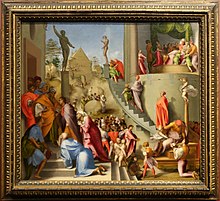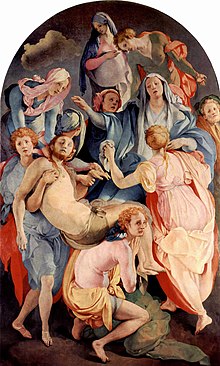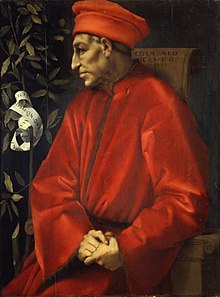Jacopo da Pontormo
Jacopo da Pontormo (born May 24, 1494 in Pontormo, today a suburb of Empoli in the province of Florence ; † January 2, 1557 in Florence , actually Jacopo Carrucci di Pontormo ) was an Italian painter and next to Rosso Fiorentino , Agnolo Bronzino and Giorgio Vasari one of the main exponents of Florentine mannerism .
He created numerous frescoes , altarpieces and portraits . Part of his work was commissioned by the Medici .
Live and act
Born on May 24th or 25th (exact date unknown), the painter was the son of the Florentine Bartolomeo di Jacopo di Martino Carucci and his wife Alessandra di Pasquale di Zanobi. The father was a painter in Ghirlandaio's workshop , but there are no known works by him. Pontormo is named after his birthplace, which is now a suburb of Empoli in the province of Florence. When Jacopo was five years old, his father died when he was ten so did his mother. From then on he lived with his grandmother Mona Brigida. Grandmother had him taught reading, writing and the basics of grammar and placed him with a distant uncle in Florence at the age of 13.
In 1508 Pontormo came to Florence, where he was successively a student of Leonardo da Vinci , Mariotto Albertinelli , Piero di Cosimo and Andrea del Sarto . His first work, documented by payment documents, was a coat of arms of Leo X with the saints Fides and Caritas for the church Santissima Annunziata in Florence. After Vasari , Michelangelo saw the work and gave the highest praise. In the next period of his work, Pontormo received many commissions from the Medici , for which he a. a. painted a portrait of Cosimo de 'Medici , called Il Vecchio , which is one of his most famous works.
In 1519 he was commissioned to furnish a hall in the Medici summer villa in Poggio a Caiano . The theme of the fresco is Vertumnus and Pomona , mythological embodiments of the garden and seasonal changes.
During the great plague in Florence, he furnished the cloister of the Carthusian monastery of Galuzzo with a cycle of passion. Pontormo's best preserved altarpiece is the Entombment of Christ in a chapel in the Florentine church of Santa Felicità, commissioned by Gino Capponi. The picture is considered a major work of Florentine Mannerism.
Pontormo's exact date of death is unknown. He was buried on January 2, 1557 in the church of Santissima Annunziata in Florence.
As a result, his work fell into oblivion or was little appreciated in art historiography because of a long devaluation of his painting in particular and Mannerism in general, which was due not least to the scathing criticism of his biographer Giorgio Vasari . A turning point in the painter's esteem only began with the studies by the American art historian Frederick Mortimer Clapp on Pontormo's picture The Entombment of Christ , published in 1912 .
Works
- Visitation, 1514–1516, fresco, 392 × 337 cm, Santissima Annunziata, Florence (image above right).
- Cosimo de'Medici il Vecchio, around 1518, wood, wood, 87 × 65 cm. Florence, Galleria degli Uffizi (image below right).
- Joseph in Egypt , 93 × 110 cm, 1515–1518, The National Gallery , London.
- Archangel Michael, around 1518–1519, fresco, 173 × 59 cm. Pontormo, S. Michele.
- Adoration of the Magi, around 1520, wood, 85 × 191 cm. Florence, Pitti Palace .
- Portrait of a lady in a red dress, wood, 90 × 71 cm. Frankfurt am Main, Städelsches Kunstinstitut
- Portrait of a young man, around 1522–1525, wood, 85 × 61 cm. Lucca, Pinacoteca Civica.
- Visitation, 1528–1529, oil on panel, 202 × 156 cm, Carmignano parish church.
- Saint Jerome as penitent, around 1528/29, 105 × 80 cm, Lower Saxony State Museum Hanover.
- Portrait of a cardinal, around 1532, wood, 103 × 86 cm. Rome, Borghese Gallery .
- The Halberdier , 1529–1530, J. Paul Getty Museum , Los Angeles
- Benjamin at the court of Pharaoh, around 1546. Rome, Palazzo del Quirinale .
Exhibitions
- Pontormo - Masterworks of Mannerism in Florence. Lower Saxony State Museum Hanover, 2013.
- Pontormo, Bronzino, and the Medici. The Transformation of the Renaissance Portrait in Florence. Philadelphia Museum of Art , 2004.
literature
- Elisabetta Marchetti Letta: Pontormo, Rosso Fiorentino . Scala, Firenze 1994, ISBN 88-8117-028-0 .
- Frederick Mortimer Clapp: Jacopo Carucci da Pontormo - His life and work. 1912. Online
- Massimo Firpo: Gli affreschi di Pontormo a San Lorenzo. Eresia, politica e cultura nella Firenze di Cosimo I. Einaudi, Turin 1997.
- Christoph Bertsch: Jacopo Pontormo, "Four Women" in Carmignano: a major work of mannerism in the field of tension between the political and intellectual upheavals of the second Florentine republic . Vienna: Böhlau, 2000, ISBN 3-205-99175-3 .
- Elizabeth Pilliod: Pontormo, Bronzino, Allori. A Geneaology of Florentine Art. Yale University Press, New Haven / London 2001.
- Carl Brandon Strehlke (Ed.): Pontormo, Bronzino, and the Medici. - The transformation of the Renaissance portrait in Florence. With essays by Elizabeth Cropper. Pennsylvania State University Press, Philadelphia, Pa. 2004.
- Giorgio Vasari: The Life of Pontormo. Edition Giorgio Vasari, Volume 4. Ed. By Alessandro Nova . Newly translated and edited by Katja Burzer. Verlag Klaus Wagenbach , Berlin 2004, ISBN 978-3-8031-5023-3 .
- Doris Krystof: Jacopo Carrucci, called Pontormo: 1494–1557 . Könemann Verlagsgesellschaft, Cologne 1998, ISBN 3-8290-0696-9 .
- Bastian Eclercy (Ed.): Pontormo. Masterpieces of Mannerism in Florence. Catalog for the exhibition in the Lower Saxony State Museum in Hanover from January 27 to May 5, 2013, Hanover, Petersberg 2013.
Web links
- Literature by and about Jacopo da Pontormo in the catalog of the German National Library
- Works by Jacopo da Pontormo at Zeno.org .
- Works by Pontormo in the Web Gallery of Art
Individual evidence
- ↑ Marchetti Letta, cit. , P. 6.
- ↑ Doris Krystof: Jacopo Carrucci, called Pontormo 1494-1557 . Könemann Verlagsgesellschaft mbh, Cologne 1998, ISBN 3-8290-0696-9 , p. 18 .
- ↑ Ralf Bormann: ways mannerist world production. Vasari, Pontormo and the German sense of form . In: Bastian Eclercy (ed.): Pontormo. Masterpieces of Mannerism in Florence . Catalog for the exhibition in the Lower Saxony State Museum in Hanover from January 27 to May 5, 2013, Hanover, Petersberg 2013, pp. 154–185.
| personal data | |
|---|---|
| SURNAME | Pontormo, Jacopo there |
| ALTERNATIVE NAMES | Carucci, Jacopo |
| BRIEF DESCRIPTION | Italian mannerism painter |
| DATE OF BIRTH | May 24, 1494 |
| PLACE OF BIRTH | Pontormo |
| DATE OF DEATH | January 2, 1557 |
| Place of death | Florence |




